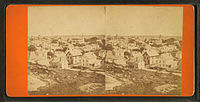
Boston
Boston (US: /ˈbɔːstən/[9]), officially the City of Boston, is the capital and most populous city in the Commonwealth of Massachusetts in the United States. The city serves as the cultural and financial center of the New England region of the Northeastern United States. It has an area of 48.4 sq mi (125 km2)[10] and a population of 675,647 as of the 2020 census, making it the third-largest city in the Northeast after New York City and Philadelphia.[4] The Greater Boston metropolitan statistical area, including and surrounding the city, is the largest in New England and eleventh-largest in the country.[11][12][13]
This article is about the U.S. city. For other uses, see Boston (disambiguation).
Boston
United States
1625
March 19, 1822
Michelle Wu (D)
89.61 sq mi (232.10 km2)
48.34 sq mi (125.20 km2)
41.27 sq mi (106.90 km2)
1,655.9 sq mi (4,288.7 km2)
4,500 sq mi (11,700 km2)
10,600 sq mi (27,600 km2)
46 ft (14 m)
675,647
654,776
13,976.98/sq mi (5,396.51/km2)
4,382,009 (US: 10th)
2,646.3/sq mi (1,021.8/km2)
4,941,632 (US: 10th)
Bostonian
$571.6 billion (2022)
- 02108–02137, 02163, 02196, 02199, 02201, 02203–02206, 02210–02212, 02215, 02217, 02222, 02126, 02228, 02241, 02266, 02283–02284, 02293, 02295, 02297–02298, 02467 (also includes parts of Newton and Brookline)
25-07000
Boston was founded on the Shawmut Peninsula in 1630 by Puritan settlers. The city was named after Boston, Lincolnshire, England.[14][15]
During the American Revolution, Boston was home to several events that proved central to the revolution and subsequent Revolutionary War, including the Boston Massacre (1770), the Boston Tea Party (1773), Paul Revere's Midnight Ride (1775), the Battle of Bunker Hill (1775), and the Siege of Boston (1775–1776). Following American independence from Great Britain, the city continued to play an important role as a port, manufacturing hub, and center for education and culture.[16][17]
The city expanded significantly beyond the original peninsula through filling in land and annexing neighboring towns. It now attracts many tourists, with Faneuil Hall alone drawing more than 20 million visitors per year.[18] Boston's many firsts include the United States' first public park (Boston Common, 1634),[19] the first public school (Boston Latin School, 1635),[20] and the first subway system (Tremont Street subway, 1897).[21]
Since the nation's founding, Boston has been a national leader in higher education and research. Boston University and Northeastern University are both located within the city. Two of the world's most prestigious and consistently highly ranked universities, Harvard University, the nation's oldest university, and the Massachusetts Institute of Technology, are both located in neighboring Cambridge, Massachusetts.[22]
Boston also has emerged as the largest biotechnology hub in the world.[23] The city is also a national leader in scientific research, law, medicine, engineering, and business. With nearly 5,000 startup companies, the city is considered a global pioneer in innovation and entrepreneurship,[24][25][26] and more recently in artificial intelligence.[27] Boston's economy also includes finance,[28] professional and business services, information technology, and government activities.[29] Households in the city claim the highest average rate of philanthropy in the United States.[30] Furthermore, Boston's businesses and institutions rank among the top in the country overall for environmental sustainability and new investment.[31]
Environment[edit]
Pollution control[edit]
Air quality in Boston is generally very good. Between 2004 and 2013, there were only four days in which the air was unhealthy for the general public, according to the EPA.[248]
Some of the cleaner energy facilities in Boston include the Allston green district, with three ecologically compatible housing facilities.[249] Boston is also breaking ground on multiple green affordable housing facilities to help reduce the carbon impact of the city while simultaneously making these initiatives financially available to a greater population. Boston's climate plan is updated every three years and was most recently modified in 2019.[250] This legislature includes the Building Energy Reporting and Disclosure Ordinance, which requires the city's larger buildings to disclose their yearly energy and water use statistics and to partake in an energy assessment every five years. These statistics are made public by the city, thereby increasing incentives for buildings to be more environmentally conscious.[251]
Mayor Thomas Menino introduced the Renew Boston Whole Building Incentive which reduces the cost of living in buildings that are deemed energy efficient. This gives people an opportunity to find housing in neighborhoods that support the environment. The ultimate goal of this initiative is to enlist 500 Bostonians to participate in a free, in-home energy assessment.[251]
Water purity and availability[edit]
Many older buildings in certain areas of Boston are supported by wooden piles driven into the area's fill; these piles remain sound if submerged in water, but are subject to dry rot if exposed to air for long periods.[252] Ground water levels have been dropping in many areas of the city, due in part to an increase in the amount of rainwater discharged directly into sewers rather than absorbed by the ground. The Boston Groundwater Trust coordinates monitoring ground water levels throughout the city via a network of public and private monitoring wells.[253] However, Boston's drinking water supply from the Quabbin and Wachusett Reservoirs[254] is one of the very few in the country so pure as to satisfy the Federal Clean Water Act without filtration.[255]
The City of Boston has eleven official sister cities:[330]
Boston has formal partnership relationships through a Memorandum Of Understanding (MOU) with five additional cities or regions:






